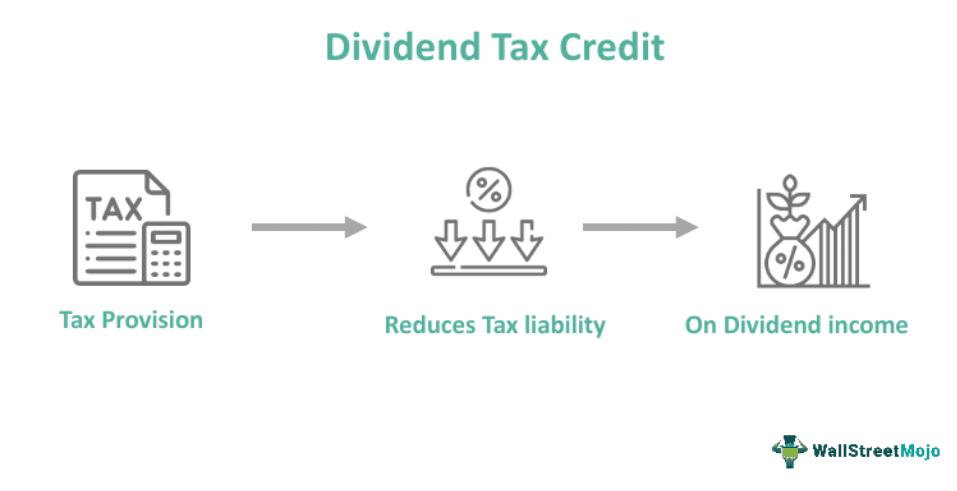Table Of Contents
What Is A Dividend Tax Credit?
A dividend tax credit is a tax provision that allows citizens to apply on their dividend income to reduce their annual tax liability. It is calculated as a percentage of the accumulated dividend income. This tax credit aims to reduce the amount of tax paid by individuals on their dividend income.

The taxpayer includes the grossed-up dividend amount as taxable income on their income tax form. However, the government allows citizens a tax credit equivalent to a grossed-up percentage to reduce tax liability. The government designed this tax provision to encourage citizens to invest. Therefore, the government fosters investments and promotes the economy's growth by providing a tax credit for eligible gains.
Key Takeaways
- The dividend tax credit is a measure to reduce tax liability on the dividend earned from companies.
- This tax credit is also designed to prevent double taxation of corporate income.
- Thus, this tax provision is intended to encourage investment in corporations and to provide a tax-efficient way for individuals to receive income from investments.
- The federal dividend tax credit rate is calculated based on the grossed-up amount of the bonus, which reflects the corporate charges paid by the corporation on the underlying earnings.
Dividend Tax Credit Explained
The dividend tax credit is a provision that helps reduce tax liability by deriving income from dividends. Every nation has a tax administration system. In the US, it is the IRS (Internal Revenue Service). Similarly, in Canada, the Canada Revenue Agency (CRA) manages the whole taxation. This form of the tax credit is common in Canada. It helps to eliminate the issue of double taxation. When a corporation earns a profit, it must pay corporate income tax. Additionally, when the corporation distributes a portion of its earnings as dividends to its shareholders, the shareholders must pay income tax on the dividends they receive.
Dividends are a portion of a company's profit distribution among its shareholders. The corporation has typically paid the taxes on these dividends as they are paid after-tax earnings. Furthermore, the dividend tax credit rate is based on the type of earnings received and the individual's tax rate. At the same time, the amount of this tax credit varies depending on the country and the bonus type received. Hence, eligible bonuses are subjected to the gross-up mechanism, the federal dividend tax credit rate for 2023 is 15.0198% for individuals whose taxable income is below the federal gains gross-up threshold and 9.215% for individuals whose taxable income is above the threshold.
Therefore, some countries offer a foreign dividend tax credit to their residents that receive gains from foreign companies. Although the gains are generally paid quarterly or yearly, claiming the proper tax credit and reporting bonuses from a sound source is essential for effective dues planning. The eligible dividends fall in the enhanced dividend tax credit category, and an individual has to pay a higher tax on it.
The taxpayer then pays a gross-up on the dividends to restore the dividend income into pretax income and earn the dividend tax credit.
Calculation Examples
Let’s assume Hagrid is a Canadian citizen. He has been a wise investor and bought many company shares on which he earns dividends. For example, let's take that Hagrid's effective tax rate is 25%. For 2022, Hagrid's eligible dividend earnings are $180. In contrast, Hagrid's non-eligible dividends account for $189.
As per CRA (Canadian Revenue Agency), the designated percentage for eligible dividends is 38%. On the other hand, for non-eligible dividends, it is 15% when Hagrid grossed up the total dividends.
Taxable income= (180 x 1.38) + (189 x 1.15)
=$248.4 + $217.35
=$465.75
Therefore Hagrid reports a total of $465.75 as his taxable income. As per the 25% effective tax rate, he will pay a tax = $465.75 x 0.25% =$116.43
#1 - For Eligible Dividends
As per CRA, the eligible dividend tax credit is set at a tax rate of 15.0198%
$248.4 x 15.0198%
=$37.30
#2 - For Non-Eligible Dividends
For non-eligible dividends, the CRA has set a tax rate of 9.0301%
$465.75 x 9.0301%
=$42.05
Summing up both eligible and non-eligible dividends, Hagrid's total tax credit will become= 37.40 + 42.05= $79.45
Subtracting this federal dividend tax credit from Hagrid's original tax payable determines the reduction which is equal to $36.98 (116.43 – 79.45)
For both eligible and non-eligible gains, these are simple calculation examples of a tax credit. Likewise, in Canada, there is both federal and provincial tax credit, which means that if Hagrid had lived in Alberta, he would have also claimed a 10% provincial tax credit which would further reduce his tax liability.
